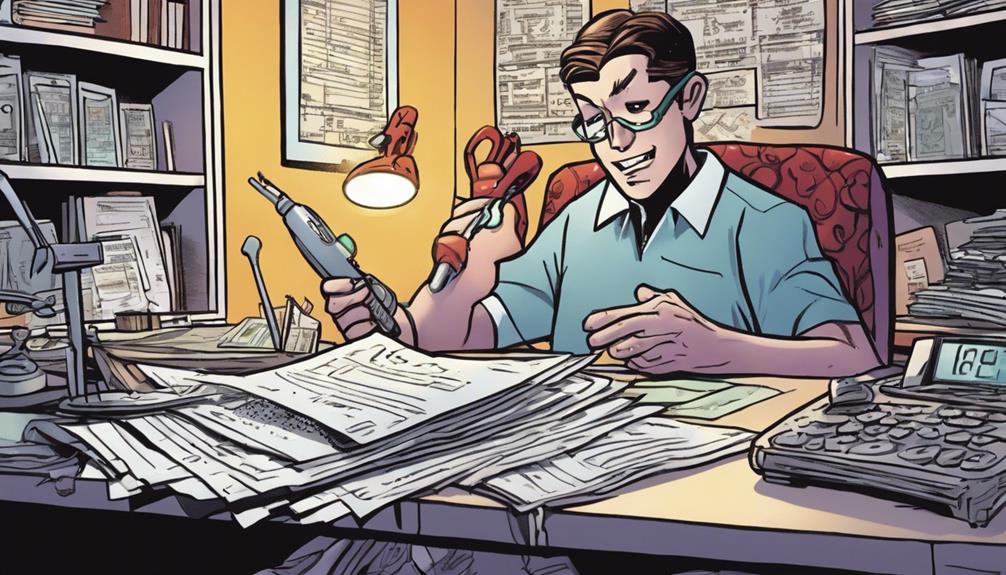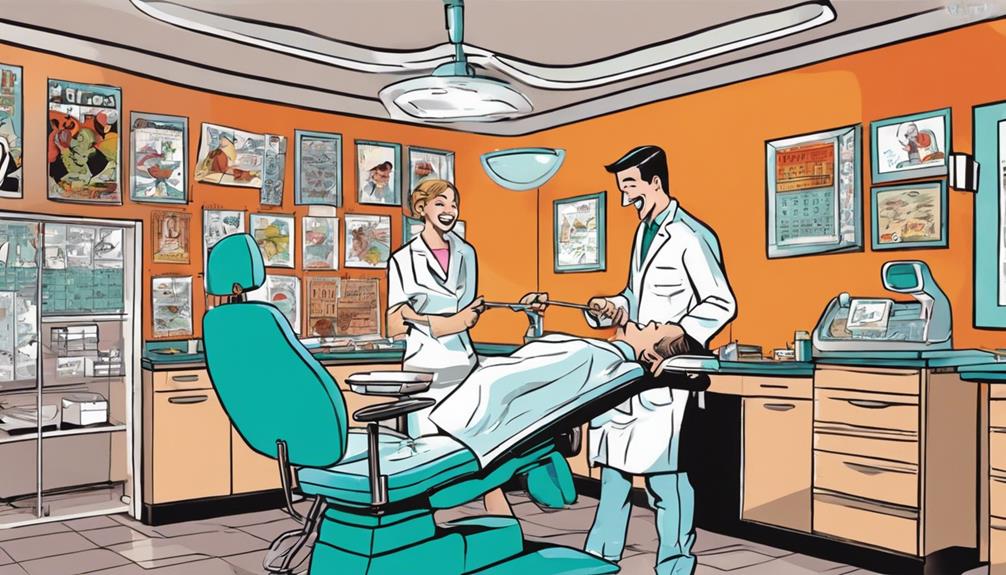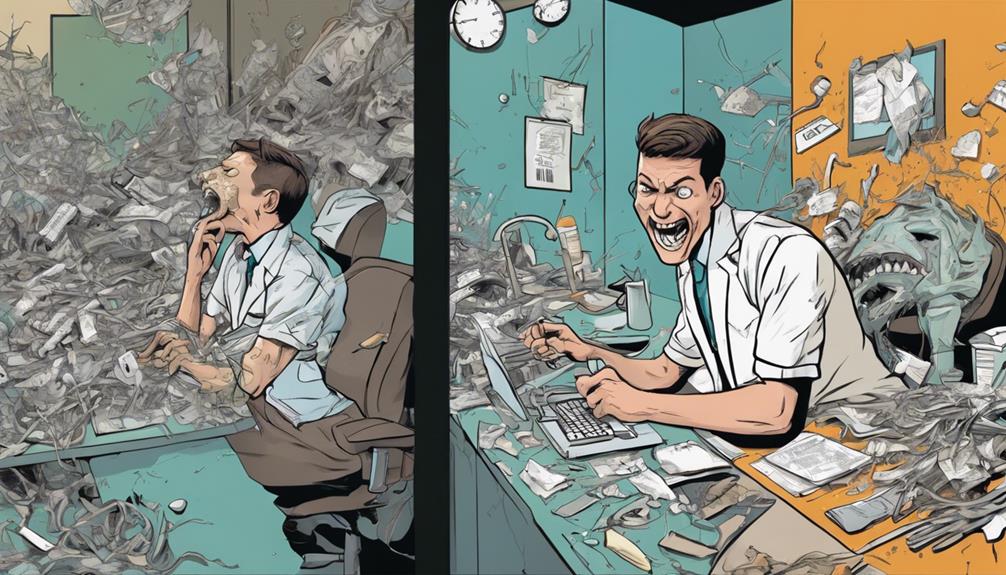To tell if your child's dentist is overcharging you, first review the itemized bill against your insurance Explanation of Benefits (EOB). Look for discrepancies, like double charges or misapplied discounts. If the dentist frequently recommends extensive treatments or pressures you for immediate payments, be cautious. Comparing typical costs of common procedures can also provide insights. Additionally, don't hesitate to seek a second opinion to validate treatment plans and costs. Staying informed about dental insurance coverage can help you spot overcharges. Keep following this guide to uncover more tips and strategies for protecting yourself against inflated dental fees.
Key Takeaways
- Review itemized bills against the insurance Explanation of Benefits (EOB) to identify discrepancies in charges.
- Look for frequent recommendations for extensive treatments, which may indicate potential overcharging.
- Compare treatment estimates with average costs for common procedures to assess fairness.
- Seek a second opinion from another dentist for validation of proposed treatments.
Recognizing Billing Discrepancies
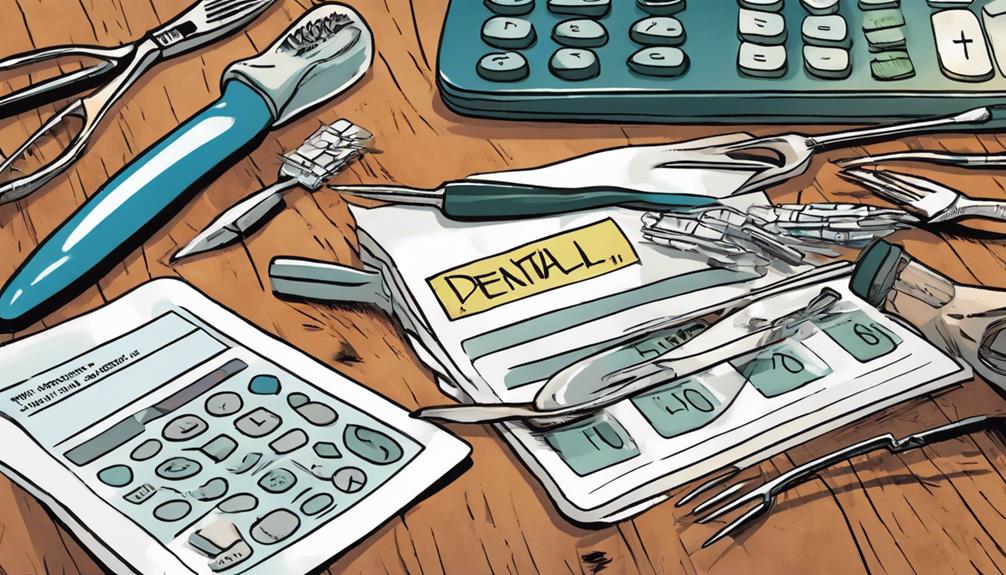
When reviewing your child's dental bills, it's important to spot any discrepancies between the itemized charges and your insurance's Explanation of Benefits (EOB).
Start by checking the billing codes used by the dental office; they should match those listed in the EOB. If you see different codes, that could indicate an error or overcharging.
Look for common discrepancies, like double charges for the same procedure or misapplied provider discounts. These mistakes can inflate your costs greatly.
Also, be aware that dental offices may use outdated or incorrect fee schedules that don't align with what insurance companies usually cover, leading to unexpected charges.
Keep all billing statements and EOBs organized, as they serve as vital evidence when disputing overcharges.
If something seems off, don't hesitate to reach out to the dental office's billing department. Clarifying any ambiguous charges and verifying their billing practices can help you avoid paying more than necessary.
Understanding Dental Insurance Coverage

When it comes to dental insurance, you need to know the types of plans available and their coverage limitations.
Understanding whether your dentist is in-network or out-of-network can help you manage costs effectively.
Types of Dental Plans
How well do you understand the different types of dental plans available, as they can greatly impact your expenses and the coverage you receive?
Many insurance plans focus on preventative care, often covering routine check-ups and cleanings at 100%. This means you can save considerably on these vital services.
However, it's important to know that dental insurance only covers a portion of many other types of dental treatment, like fillings or crowns, which often come with co-pays and deductibles that vary widely.
Some plans have lower deductibles but may limit coverage for more expensive procedures, making it important to review your plan's specifics. Additionally, dental insurance might offer benefits like flexible spending accounts (FSAs) or Health Savings Accounts (HSAs) to help manage out-of-pocket expenses.
Knowing your plan's coverage limits can prevent unexpected charges during treatment. If you choose an in-network provider, you may also experience lower costs.
Understanding these details will help you budget effectively and confirm you're not overcharged for dental services. Being informed about your dental plan empowers you to make the best choices for your child's oral health.
Coverage Limitations Explained
Understanding the coverage limitations of your dental insurance is vital to avoid unexpected costs and guarantee your child receives the necessary care. Many dental plans focus on preventative services, often covering routine check-ups and cleanings at 100%. However, they may impose higher deductibles for more extensive dental procedures, which can quickly add up.
It's important to review your plan's specifics, including co-pays and annual maximums, typically ranging from $1,000 to $2,000. Once you reach this limit, you'll be responsible for all additional expenses, potentially leading to unexpected out-of-pocket costs.
Additionally, certain common coverage limitations exist, such as exclusions for cosmetic procedures and orthodontics. Some treatments may also require prior authorization, which can complicate your understanding of what's covered.
To effectively manage your child's dental care expenses, familiarize yourself with your insurance policy's rules and limitations. This knowledge empowers you to make informed decisions and helps prevent surprises at the dentist's office. By being proactive, you can guarantee your child receives the necessary care without breaking the bank.
In-Network Vs. Out-Of-Network
Knowing the specifics of in-network versus out-of-network dentists can help you avoid unexpected costs and guarantee you're maximizing your dental insurance benefits. In-network dentists have agreements with your insurance company, offering services at reduced rates, which leads to lower out-of-pocket expenses. In contrast, out-of-network dentists may charge higher fees, resulting in more considerable costs for you.
Here's a quick comparison:
| Factor | In-Network | Out-of-Network |
|---|---|---|
| Costs | Lower out-of-pocket | Higher out-of-pocket |
| Coverage for Preventive Care | Often 100% covered | Typically less covered |
| Reimbursement Rate | Higher reimbursement | Lower reimbursement |
| Treatment Authorization | Easier to navigate | More complicated |
| Network Verification | Confirmed by the insurance company | May require more effort |
Understanding these differences can greatly impact your overall dental care expenses. Always verify a dentist's network status before treatment to avoid potential overcharges and financial surprises. By choosing in-network providers, you can guarantee that you're getting the most out of your dental insurance plan.
Red Flags for Overcharging
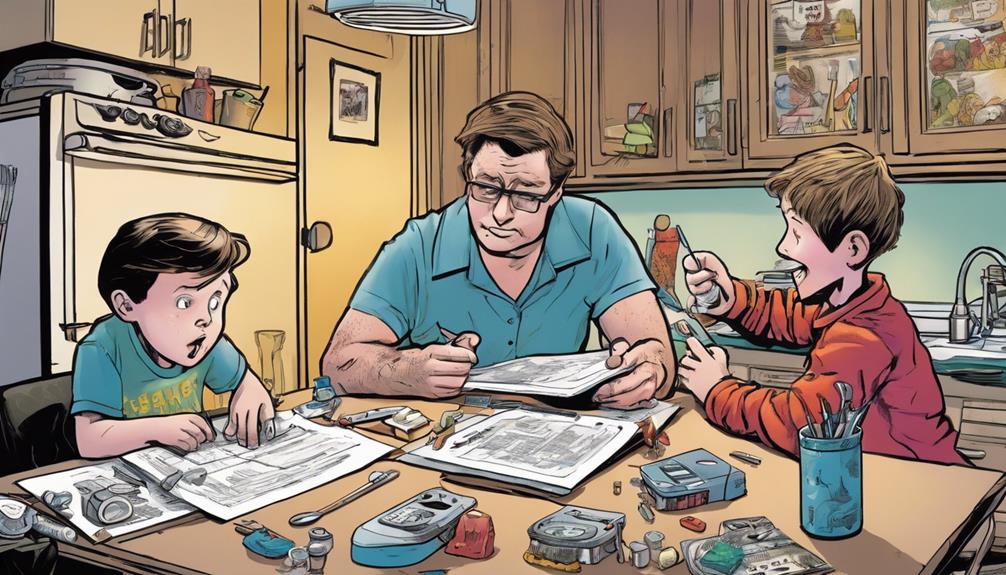
Watch for red flags that suggest your child's dentist might be overcharging you. If you notice that the dentist frequently recommends extensive and unnecessary dental treatments, especially those not mentioned in prior visits, it could be a sign of overcharging. Compare treatment estimates with average costs for common pediatric procedures; if they're considerably higher, consider getting a second opinion. Also, be wary of dentists who insist on using brand-name products or services that seem unnecessary. Additionally, if your child’s dentist pressures you into paying out-of-pocket for treatments that should be covered by insurance, it’s another red flag. It’s important to be vigilant about potential overcharging, as research has revealed a shocking dental health connection to overall well-being. These signs of dental overcharging can not only lead to financial strain, but they can also impact the trust and relationship between you and your child’s dentist. If you have concerns about potential overcharging, don’t hesitate to discuss them with the dentist or seek a second opinion from another dental professional. Being proactive about monitoring your child’s dental care can help ensure they receive the necessary treatments at a fair cost.
Also, keep an eye on any discrepancies between your dental office's billing and the Explanation of Benefits (EOB) from your insurance. Inconsistencies can indicate overcharging or billing errors.
Be cautious if the dentist pressures you for immediate payment or pushes costly procedures without transparent justification—this often means they're prioritizing profit over patient care.
Lastly, if your child's dentist offers promotions or deals that seem too good to be true, proceed with caution. These offers can sometimes hide recommendations for unnecessary treatments designed to recoup costs.
Communicating With the Dental Office
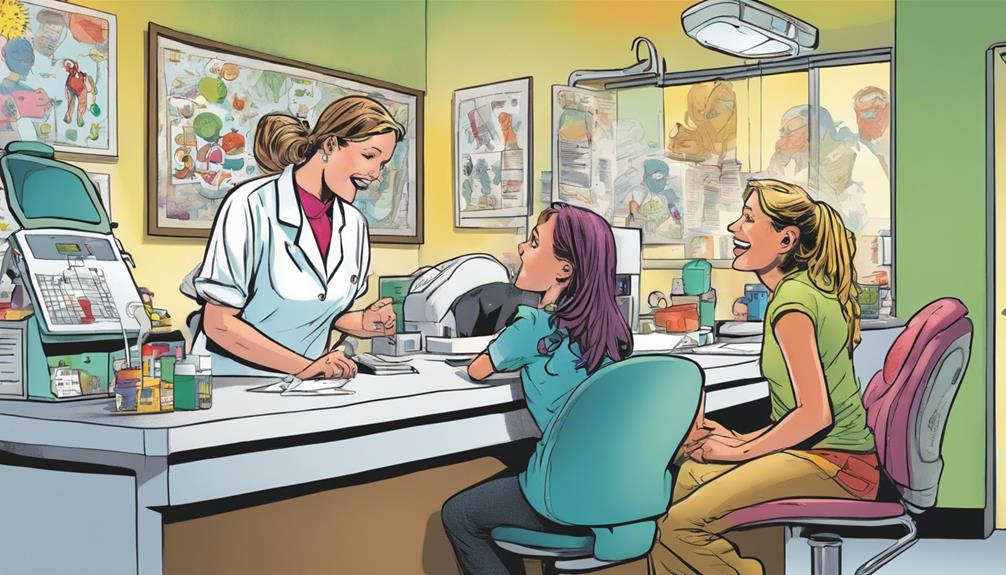
When you're managing your child's dental costs, clear communication with the dental office is key.
Start by requesting an itemized billing statement to spot any discrepancies and clarify your insurance coverage details.
Don't hesitate to discuss the necessity of treatments openly, as this can help you understand what you're really paying for.
Request Itemized Billing Statement
Requesting an itemized billing statement from your child's dentist can help you spot any discrepancies and guarantee you're only paying for necessary services. An itemized billing statement provides a detailed breakdown of charges, allowing you to verify that you're not overpaying for treatments related to dental problems.
Here are three key reasons to ask for one:
- Transparency: An itemized bill should clearly outline each procedure, its cost, any discounts applied, and the amount covered by insurance.
- Verification: Compare the itemized statement with your Explanation of Benefits (EOB) to ascertain the charges align with your insurance coverage and negotiated rates.
- Dispute Support: Keeping a record of itemized bills and EOBs helps you track billing inconsistencies, making it easier to dispute charges if needed.
If you notice unexpected charges, don't hesitate to contact the dental office's billing department for clarification.
Clarify Insurance Coverage Details
To guarantee you fully understand your child's dental costs, clarify insurance coverage details directly with the dental office. Start by confirming whether your child's dentist is in-network. Being out-of-network often leads to higher out-of-pocket expenses due to different fee schedules.
Next, ask the dental office for an itemized bill that outlines each procedure and its associated costs. This transparency is vital for identifying any discrepancies in claims the patient may have.
Additionally, inquire about any dental deductibles or coverage limitations that could affect your child's treatment costs. Understanding these details can greatly impact your financial responsibility.
Regularly reviewing your dental insurance plan's benefits is also essential. Make sure you know which procedures are fully covered by insurance and which ones may incur additional costs.
Discuss Treatment Necessity Transparently
Understanding the charges on your child's dental bill sets the stage for open conversations about the necessity of recommended treatments. To guarantee transparency regarding treatment necessity, consider these key steps:
- Request an itemized bill: Always ask for a detailed breakdown of charges. This helps you compare what's being billed against your dental insurance plan and the Explanation of Benefits (EOB).
- Engage in open communication: Don't hesitate to discuss any treatments that seem extensive or unfamiliar. A good dental office should provide clear explanations and the rationale behind their recommendations.
- Seek a second opinion: If you're unsure about a proposed treatment, consulting another dental professional can give you peace of mind. This second opinion can validate the necessity of the care suggested.
Comparing Treatment Costs

Comparing treatment costs from different dentists can help you spot potential overcharges and confirm you're getting fair pricing for your child's dental care.
Start by gathering estimates for common pediatric dental procedures like routine cleanings, which usually range from $75 to $200. If your child's dentist charges considerably more, it's worth asking why. For fillings, costs typically fall between $150 and $300, depending on the materials used. Higher prices might suggest overcharging or unnecessary procedures.
Don't overlook the costs of more complex treatments, such as root canals in primary teeth, which can range from $700 to $1,500 based on their complexity. Utilizing tools like OkCopay can be invaluable in evaluating fair pricing for these dental treatments.
When discussing estimates, ask for detailed breakdowns of the costs associated with any proposed procedures. This will help you avoid unexpected charges and clarify what's necessary for your child's dental health.
Seeking Second Opinions

Getting a second opinion can provide reassurance that your child's dental treatment plan is necessary and reasonably priced. Consulting with another dental professional can help you confirm whether the proposed procedures are essential or if they might be unnecessary.
Here are some key steps to take into account:
- Consult Multiple Dentists: Seek out opinions from different dental professionals. This can highlight any discrepancies in diagnoses or treatment recommendations.
- Research Costs: Before visiting another dentist, research the average costs of the recommended treatments. This information can help you gauge if the initial estimates were fair.
- Request Documentation: Don't hesitate to ask for copies of X-rays and treatment plans. Sharing this information with the second dentist can facilitate a more thorough evaluation of your child's needs.
Many dentists value transparency and may even suggest colleagues for second opinions.
Remember, understanding your options guarantees you're making well-informed decisions about your child's dental care.
Protecting Your Rights as a Patient

As you seek second opinions to confirm your child's dental care is necessary, it's equally important to know your rights as a patient to protect yourself from overcharging. You have the right to request itemized bills that clearly explain all charges related to dental procedures. This transparency in billing practices helps you identify any discrepancies that may arise.
If you notice unexpected charges, don't hesitate to challenge them. You can contact your dental office or insurance company for clarification. Remember, X-rays and diagnostic images legally belong to you, and you can request them to make informed decisions about treatment options.
In a world where dental mills may prioritize profit over patient care, knowing your patient rights becomes critical. Honest dentists will respect your decision to seek second opinions and provide the necessary information for comparison.
Additionally, state dental boards and consumer protection organizations exist to advocate for patients facing unfair treatment or questionable billing practices. By understanding your rights, you empower yourself to confirm your child receives appropriate dental care without being overcharged.
Frequently Asked Questions
How to Know if a Dentist Is Charging Too Much?
To know if a dentist's charging too much, compare their fees for common procedures with local averages. You should also review your insurance coverage, request itemized estimates, and monitor billing statements for errors.
How to Tell if a Dentist Is Scamming You?
Ever felt uneasy about a dentist's recommendations? If they pressure you into unnecessary treatments, suggest numerous unneeded procedures, or frequently recommend non-covered treatments, it's time to question their motives and protect your wallet.
What Are the Signs of a Bad Dentist?
To spot a bad dentist, watch for sudden, extensive treatment recommendations, pressure to decide immediately, frequent unnecessary procedures, unclear billing, and reluctance to discuss findings openly. Trust your instincts and seek a second opinion if needed.
How to Know if a Dentist Is Lying About a Cavity?
Ever wondered if your dentist's claims are just smoke and mirrors? Trust your instincts; ask to see X-rays, seek a second opinion, and know the signs of cavities. Stay informed to protect your child's dental health!
Conclusion
Keeping an eye on your child's dental expenses is like being a vigilant gardener; you need to prune away any overcharging weeds to guarantee your financial landscape flourishes.
By recognizing discrepancies, understanding insurance, and seeking second opinions, you cultivate a healthy relationship with your child's dental care.
Remember, you're not just protecting your wallet; you're nurturing your child's smile, ensuring it blooms brightly and confidently in the future.
Stay informed, and your efforts will bear sweet fruit.
